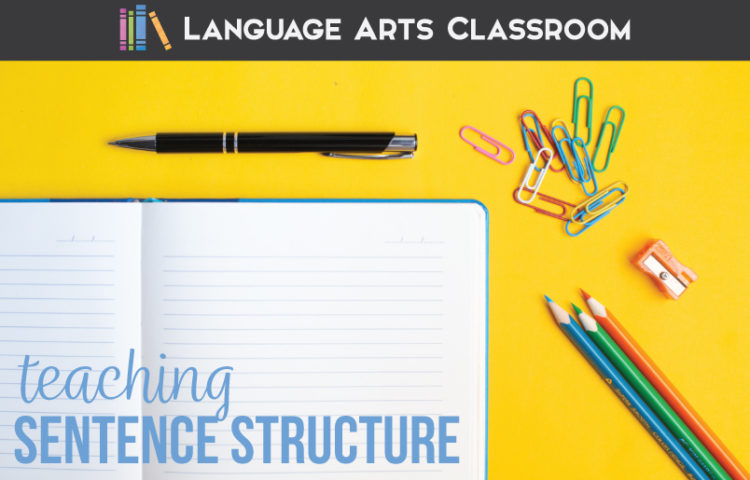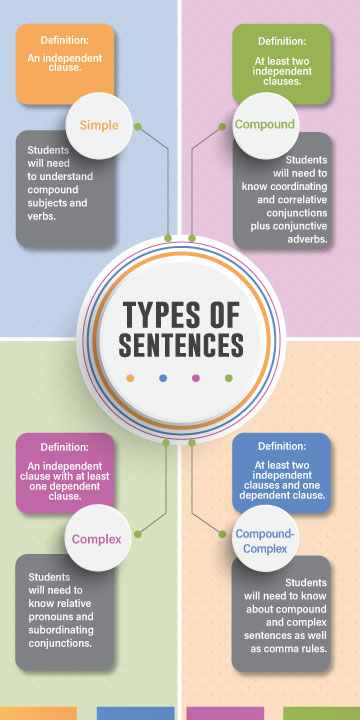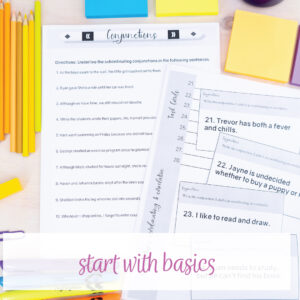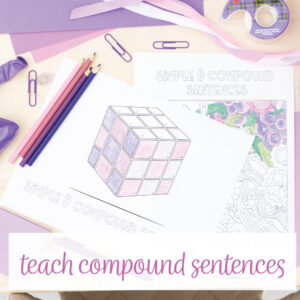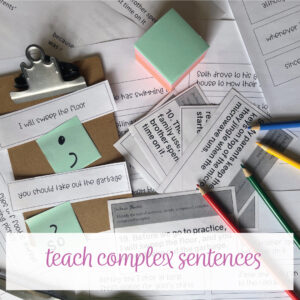Looking for helpful grammar lesson plans on how to teach sentence structure? In this post, I’ll share ideas for teaching sentence structure with simple, compound, complex, and compound-complex sentences.
Since I have taught both middle school and high school language arts, I feel that my understanding of the language standard’s scope helps me in my current teaching position. When I work with high school classes by connecting writing and grammar, I realize the purpose of those detailed requirements.
For instance, most sixth grade standards require a depth of pronoun use. In high school, students write complicated sentences and read complicated writing. If readers do not understand the purpose of pronouns and their antecedents, older students can become confused.
How can you help students understand the importance of sentence structure?
To help students understand the importance of sentence structure, provide them with real-life examples that demonstrate how sentence structure affects clarity and meaning. Engage them in activities that involve sentence rearrangement to show how different structures can convey different ideas and emotions.
Furthermore, take a look back at where your learners have been. For instance, when classes study sentence structure in seventh grade, I realize that the concepts might not make perfect sense at that time. However, students will need to break down sentences and consider punctuation as their reading material advances. To help them understand sentence structure, I break down concepts to reach all students. As a high school teacher, I know the potential “holes” in understanding and how to fix them.
My activities for sentence structure encompass everything—punctuation, conjunctions, phrases, clauses, and the actual sentence types. Sometimes I return to direct sentence structure lessons with my older students.
How to teach sentence structure?
Before we cover the four structures (pictured below), lets dive into the considerations and the best ways for covering basic sentence structure, different parts of a sentence, and favorite activities.
Language and grammar considerations.
First, students might not be ready for your sentence structure lesson. We teachers scaffold, adjust, tweak, and reconfigure. Simple, compound, complex, and compound-complex sentences: These sentences are tough to recognize, use, and punctuate. Your students might be intimidated with sentence structure activities, and they might need support or review. (I have plenty of ideas below.)
Second, most learning standards dictate that students learn sentence structure (types of sentences) in seventh grade. That makes perfect sense! After learning phrases and clauses, students should apply that information to simple, compound, complex, and compound-complex sentences. Then, when students arrive at high school, we can manipulate and analyze sentence structure in our writing, literature, and nonfiction. However, we ELA teachers might complete direct instruction with sentence structure at various grades. As a high school English teacher, I expect to review concepts, especially in student writing.
Finally, give yourself grace your first sentence structure lesson. I’m going to walk you through my process and give you suggestions. Just like anything in teaching, the first time through a lesson, you might stumble. You will be able to still meet the standards and complete your sentence structure lesson plan! This post aims to help you as you fine-tune your methods for teaching sentence structure.
Honestly, teaching sentence structure can be engaging and rewarding because students will easily see implementation into their writing. Here are my ideas for making meaningful sentence structure activities.
Considerations with some tools.
To begin, the infographic (above) is for you and your students. Please right click on the picture, save it, and show it to your students. Upload it to Google Classroom if you’d like. Doing so firstly shows students that you have a plan for them. Secondly, students will know what to expect and understand that some concepts are requirements for understanding types of sentences. Finally, you will have all of the definitions and expectations in one spot as you continue teaching sentence structure. Parents and students alike appreciate this.
Take notes about what works for you and what WON’T work for you situation with the process below.
Background considerations with predicates, conjunctions, punctuation, clauses. . .
To start teaching sentence structure, consider where your students are with their grammatical knowledge. For instance, before students use sentence structure with purpose, they might need time for working on phrases and clauses. (I developed a phrases and clauses grammar set for download that includes a presentation, notes and classroom activities.) Your freshmen might be ready to work on applying sentence structure to their writing. Meet students where they are so that they are ready for the next step.
With sophomores and above, you maybe can focus on sentence structure activities that require higher level thinking. Often with sophomores, the goal is to finish the year working on sentence structure and their punctuation—the semicolon standard in my Common Core school. (All of my subscribers have access to my free comma sheet which is helpful with any sentence structure lesson.)
For juniors and seniors, enforcing those punctuation rules and working those higher-thinking skills is the goal. Students should be able to identify the types of sentences in what they read and examine how the author expressed their message. Additionally, students should decide how their sentences provide meaning in their writing.
Now that we’ve considered a few ideas, below is my method for how to teach sentence structure. You should take into account what works for your community.
Considering every sentence structure lesson plan, here is a glimpse.
Assess student understanding of concepts related to sentence structure.
Classes should understand phrases and clauses and conjunctions. If I am working with students and need data, I use a portion of a pretest. Using a pretest before diving into sentence structure lessons allows me to show students growth.
Then, we review the knowledge needed for succeeding with types of sentences like a quick subject and verb review. (That is a free subject and verb download.) Note what other prior concepts to review like conjunctions or relative pronouns.
After understanding where students are in their understanding, work through each sentence structure type. I spend about a week per type of sentence—without teaching grammar the entire class period. Complex and compound-complex do take longer than simple and compound sentences in my experience.
Finally, I give students tools to help them if they practice outside of class. In my sentence structure bundle, I have a detailed presentation that I simply share on Google Classroom so that we can consult all those ideas throughout our lessons.
Teach simple sentences.
Don’t skip over simple sentences! I use a presentation and station activity to really clarify the ways simple sentences can look.
Some teaching tips for simple sentences:
- Define simple sentences: they contain a subject and a verb, and either one of those can be compound. Don’t think that these “easy” sentences can get a fast explanation. Students must be able to identify an independent clause for other sentences. Plus, if students understand this first concept, they hopefully will have more confidence for the other three!
- I often use metaphors to teach grammar, and the ice cream cone is one I use with simple sentences. A simple sentence has one scoop of ice cream. Compound? Two scoops. It might sound goofy, but students do remember this grammar metaphor.
- Ask students to write them. You don’t have to grade this practice; allow students to share with their classmates
- Create simple sentences with compound subjects together, and then practicer writing compound verbs.
- Find simple sentences in literature.
Spend two or three days (often, I spend a week) covering simple sentences. Practice them in a variety of ways.
As students become more comfortable with simple sentences, ask students to include two or three in a writing assignment. Then ask students to evaluate their use. Do simple sentences provide a specific impact? Should some sentences not be simple? Looking at sentence writing naturally transitions your lessons to compound sentences.
A final note: don’t hesitate to review coordinating and correlative conjunctions. Students normally need a quick reminder. I do provide direct instruction so that students can reference their notes.
Teach compound sentences.
Combine simple sentences together from the previous week’s lessons, and build on students’ prior knowledge. Typically, I complete lots of fun work in small groups with simple and compound sentences with a grammar coloring activity. Learners write compound sentences every day, but many of them forget to use proper punctuation. Review that component with them as well.
Remember: every time you emphasize that young writers already own the pieces of understanding sentence structure, you are not only building their confidence, but you are also showing them that grammar is a tool to help them to communicate effectively.
To do that, continue to play with simple and compound sentences. I often pull sentences from students’ work anonymously. To do so, I copy and paste sentences from digital work into a presentation for the class. Doing this allows me to praise classes for writing such powerful sentences. We apply our grammar concepts specifically to their writing.
Finally, if anyone seem confused, I do not move to the next step. I might review with some direct instruction or return to my presentation to emphasize basics.
Teach complex sentences.
My compound sentence lesson plan is often a bridge from simple to complex sentences. Coordinating and correlative conjunctions can be in both simple and compound sentences, so those sentence structure activities fit together nicely.
Then, review subordinating conjunctions. We memorize these conjunctions, and my classes often call them ASWABIs. (That pneumonic sounds like a medical term to me, but they remember it!) After students can recognize subordinating conjunctions and relative pronouns, we begin highlighting dependent clauses in complex sentences. Again, I provide direct instruction before we begin writing and identifying complex sentences.
Often, I will take a compound sentence activity and add dependent clauses to show students how we can easily make complex sentences. Building off a previously successful activity (again) prompts writers to continue their work with sentence structure.
As classes write complex sentences, we cover comma rules. (You can also download that handout for free in that post.) We do cover comma rules with compound sentences, but I find that I reference that sheet frequently as we cover sentence structure.
Finally, I use sentence manipulatives to show students how they can build complex sentences, how they can purposefully use punctuation and conjunctions to convey their messages, and how they can combine clauses for maximum effect.
Teach compound-complex sentences.
Before I work on compound-complex sentences, we practice identification and writing the three types of sentences together. Classes might need a quick review at this point. I rely on color by grammar to review the three types of sentences so far. This coloring activity encourages students to reread the questions so that they get the coloring right, and I like that extra emphasis. You could also do a quick Google quiz review if you don’t have time for coloring. Don’t worry if you think you’re teaching sentence structure slowly; you’re not. As you continue with sentence structure activities, you’ll continue adding punctuation lessons and writing mini-lessons. You are teaching SO much more!
Finally, we add all the pieces together for compound-complex sentences. We play with the language with our manipulations or sticky notes. Often, I treat this portion as a review of all the sentences. Everyone will create a simple sentence, then add another independent clause for a compound sentence, and then they will add a dependent clause for a compound-complex sentence.
You can have classes write a paragraph that uses all of the sentences or you can write a paragraph together. Discuss concepts: when does a simple sentence work? When is a complex sentence effective? Any time that you can connect grammar to writing, take the opportunity to do so. The practice might feel forced at first, but eventually, your integration of grammar terms will be natural.
Finally. . .
As you close sentence structure activities, gather data with a quick exit ticket activity. If classes do well, continue discussions about sentence structure with student writing. If they need more practice, circle back to the grammar manipulations. (You can also use sticky notes to create pieces of sentences like I have pictured on the complex sentence portion.) Other times, I simply ask students where their trouble is. I provide targeted practice for that area.
Another tip: reference the infographic as you teach! It has definitions, and learners can keep a copy pulled up on their devices.
Types of sentences worksheets, hands-on pieces, and grammar sorts sprinkled with direct instruction, writing, and guidance will create a successful experience. If you are looking for many of the materials mentioned in this post, you can see my sentence structure bundle.
How do you incorporate grammar rules into your lessons on sentence structure?
How to teach sentence structure? You have some choices, and you should consider what will best serve your classes.
If you are looking for similar posts, check out my ideas about reviewing complete sentences, teaching subjects and predicates, and writing skills.

